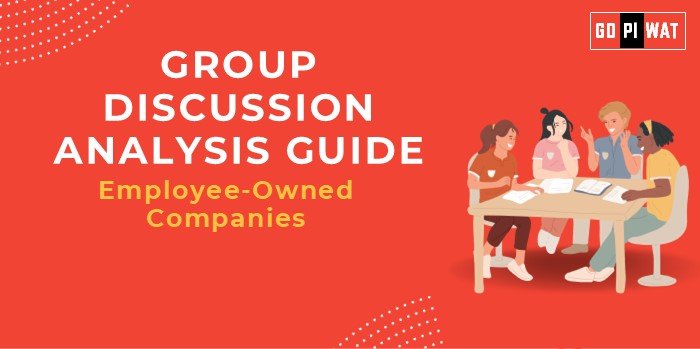📋 Group Discussion Analysis Guide
🌐 Topic: Employee-Owned Companies
💡 Introduction to Employee-Owned Companies
- Opening Context: “As companies increasingly look for sustainable and equitable models of ownership, employee-owned companies have emerged as a competitive alternative to traditional corporate models, gaining traction globally for their unique governance and incentive structures.”
- Topic Background: Employee-owned companies are businesses where employees hold a significant share of the company’s ownership, often via structures like Employee Stock Ownership Plans (ESOPs). Originating in the 1950s in the United States, they aim to align employees’ interests with the company’s performance, fostering motivation and productivity. Global success stories like John Lewis Partnership in the UK demonstrate their potential.
📊 Quick Facts and Key Statistics
- 🌍 Global Employee-Owned Firms: Over 6,500 companies in the U.S. alone operate under ESOPs.
- 📈 Productivity Increase: Employee-owned firms report a 4-5% higher productivity post-transition.
- 🔄 Retention Rates: 50% lower employee turnover compared to traditional firms.
- 💰 Wealth Creation: ESOP-owned companies contribute significantly to employees’ retirement savings, distributing $1.4 trillion in assets.
- 🏆 Global Example: John Lewis Partnership in the UK employs over 80,000 partners, who share profits.
👥 Stakeholders and Their Roles
- Employees: Owners and contributors, they benefit through equity growth and profit-sharing.
- Management: Key to implementing ownership transitions and fostering participatory leadership.
- Government: Offers tax benefits and legal frameworks encouraging employee ownership.
- Shareholders: Transition from majority to employee ownership influences governance.
- Customers: Benefit indirectly from better service quality due to high employee morale.
✅ Achievements and Challenges
Achievements:
- 📈 Improved Productivity: Firms experience a productivity boost due to shared ownership incentives.
- 🔒 Enhanced Retention: Employees are more committed, reducing turnover costs.
- 💰 Profit Redistribution: Wealth is more equitably distributed among employees, enhancing financial security.
- 🌐 Resilient Operations: Employee-owned firms often demonstrate better crisis resilience (e.g., 2008 recession survival rates).
Challenges:
- 💸 Transition Costs: High upfront legal and operational costs for transitioning ownership.
- ⚖️ Governance Complexity: Balancing collective decision-making with operational efficiency.
- 📉 Capital Access: Employee-owned firms may struggle to raise external funding.
🌍 Global Comparisons
- 🇬🇧 United Kingdom: John Lewis Partnership thrives as an employee-owned retail giant.
- 🇪🇸 Spain: Mondragon Corporation, a cooperative network, demonstrates global scalability.
📚 Structured Arguments for Discussion
- Supporting Stance: “Employee-owned companies are outperforming traditional corporations through improved productivity, higher retention, and equitable profit distribution.”
- Opposing Stance: “Governance inefficiencies, high transition costs, and capital limitations make employee-owned companies less competitive than traditional corporate models.”
- Balanced Perspective: “While employee-owned firms face challenges, their productivity gains and resilience showcase a promising alternative to traditional models.”
💬 Effective Discussion Approaches
- Opening Approaches:
- “Employee-owned companies like John Lewis Partnership showcase the power of shared ownership in driving productivity and loyalty.”
- “The global rise of ESOPs challenges traditional corporate models, proving that profit and equity can coexist.”
- Counter-Argument Handling:
- Challenge: “High transition costs limit feasibility.”
- Rebuttal: “Long-term benefits, like higher retention and employee satisfaction, offset initial costs.”
- Challenge: “Governance complexity slows decision-making.”
- Rebuttal: “Firms adopting hybrid structures balance employee voice with leadership efficiency.”
🧐 Strategic Analysis of Strengths and Weaknesses
- Strengths: Improved employee morale and productivity, wealth redistribution, and reduced turnover.
- Weaknesses: Transition costs, governance hurdles, and difficulty accessing capital.
- Opportunities: Scaling models like Mondragon to other sectors, government incentives promoting employee ownership.
- Threats: Economic downturns impacting equity value, resistance from traditional investors.
📖 Connecting with B-School Applications
- Real-World Applications: Analyze employee-owned structures in MBA case studies on organizational behavior, corporate governance, and strategy.
- Sample Interview Questions:
- “How do employee-owned companies contribute to sustainable business practices?”
- “What are the challenges of transitioning to employee ownership?”
- Insights for B-School Students: Focus on stakeholder alignment and shared value creation. Explore case studies like Mondragon for innovative governance solutions.


